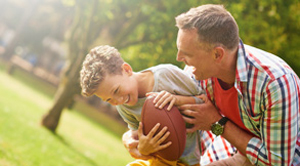Know the Score: Wearing Eye Protection Prevents Players from Getting Benched Due to Injury
 Sports-related eye injuries cause an estimated 100,000 doctor visits each year. Yet, most of these injuries can be prevented by wearing eye protection. In fact, a recent study of high school field hockey players shows that traumatic eye injuries fell 67 percent after eye protection became mandatory. In support of Sports Eye Safety Month in April, Insight Eye Specialists and the American Academy of Ophthalmology are offering athletes of all ages guidance on how to best protect their eyes.
Sports-related eye injuries cause an estimated 100,000 doctor visits each year. Yet, most of these injuries can be prevented by wearing eye protection. In fact, a recent study of high school field hockey players shows that traumatic eye injuries fell 67 percent after eye protection became mandatory. In support of Sports Eye Safety Month in April, Insight Eye Specialists and the American Academy of Ophthalmology are offering athletes of all ages guidance on how to best protect their eyes.
Common sports eye injuries include corneal abrasions, lacerations and bleeding in the eye. Basketball players tend to get poked in the eye with fingers. Tennis and softball players more often get hit with fast moving balls. In contact sports like football and martial arts, more severe ocular injuries such as retinal detachment and orbital fracture occur. One-third of sports related eye injuries happen to kids.
The good news is that 90 percent of eye injuries can be prevented with the use of protective eyewear. Save your vision while playing sports by following these tips:
- Wear the right eye protection: For basketball, racquet sports, soccer and field hockey, wear protection with shatterproof polycarbonate lenses.
- Put your helmet on: For baseball, ice hockey and lacrosse, wear a helmet with a polycarbonate face mask or wire shield.
- Know the standards: Choose eye protection that meets American Society of Testing and Materials (ASTM) standards. See the Academy’s protective eyewear webpage for more details.
- Throw out old gear: Eye protection should be replaced when damaged or yellowed with age. Wear and tear may cause them to become weak and lose effectiveness.
- Glasses won’t cut it: Regular prescription glasses may shatter when hit by flying objects. If you wear glasses, try sports goggles on top to protect your eyes and your frames.
“Virtually all sports eye injuries could be prevented by wearing proper eye protection,” said ophthalmologist Philip R. Rizzuto, M.D., clinical spokesperson for the Academy. “That’s why I always strongly encourage athletes to protect their eyes when participating in competitive sports.”
Anyone who experiences a sports eye injury should immediately visit an ophthalmologist, a physician specializing in medical and surgical eye care.
For more information on sports eye safety, see the American Academy of Ophthalmology’s EyeSmart® website at www.aao.org/eye-health.
Comments are closed.

